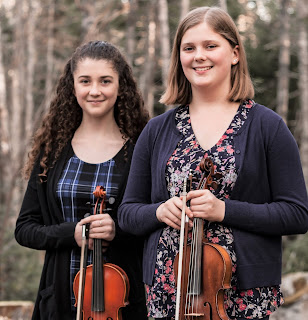Up With Gaelic
 When
Abby and Ella Hanson sat down with Arts
East at the beginning of May, it was the start of Gaelic Nova Scotia
Month and the siblings had just wrapped up a presentation at the Halifax
Central Library.
When
Abby and Ella Hanson sat down with Arts
East at the beginning of May, it was the start of Gaelic Nova Scotia
Month and the siblings had just wrapped up a presentation at the Halifax
Central Library.
Although
young (Abby 16, Ella 14), the sisters are having an important impact on Gaelic
education in their home province. As the founders of Up With Gaelic, the pair
visit schools around mainland Nova Scotia, promoting the preservation of
Scottish Gaelic culture and tradition.
“Both
our parents are in the education system,” says Abby. “We had heard a lot about how
Gaelic culture was on the social studies curriculum in grade schools, but there
were almost no resources to actually teach it. So, with the help of our mom and
what we had learned from our Gaelic teachers, we put the presentation together.”
At
first, one of the biggest challenges was getting people to take them seriously.
“A
couple of times in the beginning we would go into classes and people would say,
‘Oh, we didn’t think you would actually be students,’” shares Abby. “They were
expecting adults.”
Abby
and Ella’s maternal great-great grandmother only spoke Gaelic when she first emigrated
to Nova Scotia. As the language was frowned upon at the time, Gaels were
discouraged from speaking their mother tongue outside of their own homes. Over
time, led to a loss of the language in Gaelic households, including that of Abby
and Ella’s family. However, the pair are now working their way back to Gaelic
fluency - and their mother has started learning, too. Up With Gaelic is their
chance to share their studies.
The
duo balance their own schoolwork with their elementary school visits. They
started off with 30-minute presentations, but soon bumped them up to an hour after
realizing that they needed more time to cover everything properly. Though the sessions
vary slightly depending on the students’ ages, the core is always the same: Gaelic
culture in Nova Scotia. The teens take their audiences from the Gaels’
lifestyle in Scotland - residing in blackhouses, spinning wool and caring for cattle
- to their journey to Canada. They bring interactive elements to the classroom
as well, including a milling song.
The
sisters weren’t always as enthusiastic about learning Gaelic as they are now,
but they started participating in Na Gaisgich Òga (a Gaelic mentorship program
for youth) run by the Gaelic College in St. Ann’s, Cape Breton five years ago. Already
violinists (soon to be fiddlers), they were drawn by the musical side of the
culture.
“I
really liked learning the singing,” smiles Abby. “I had a faint idea that it was
part of my family heritage - that my ancestors had spoken Gaelic - and I slowly
became more interested as I went along and started taking more classes.”
For
Ella, it wasn’t until the second year of participating in the Caidreamh na Cloinneadh (Summer Youth Gaelic
Immersion program) that she became invested in learning to speak Gaelic.
“I
really enjoyed learning the language and figuring it out. Like with friends, I
got to speak with them in Gaelic and they got to speak back, which is pretty
cool.”
“We
did it as well this past year. It was also fun because I could completely
understand what everyone was saying, and I could hold a conversation- which was
really neat and special because I was speaking the language of my ancestors.”
Ella
has also taken to step-dancing, which she happily demonstrates during the Up
With Gaelic presentations.
Although
neither of the girls have immediate goals of teaching Gaelic full-time, they
want to continue sharing the culture with young students for as long as they
can. Based on their experience, they believe that young people today are still interested
in learning about Gaelic culture.
“We
went to the Gaelic College one year and one of the organizers said, ‘We had a
family here last week and they came because their daughter had heard about it
through your presentation,’” recalls Abby. “That was so amazing that they had
remembered it for that long.”
Abby
and Ella say that, if they have children of their own, they will be happy to
pass the language along to them.
“Just
look around,” says Ella. “Gaelic might not be an active part of our everyday culture,
but it is still a huge part of our life.”


